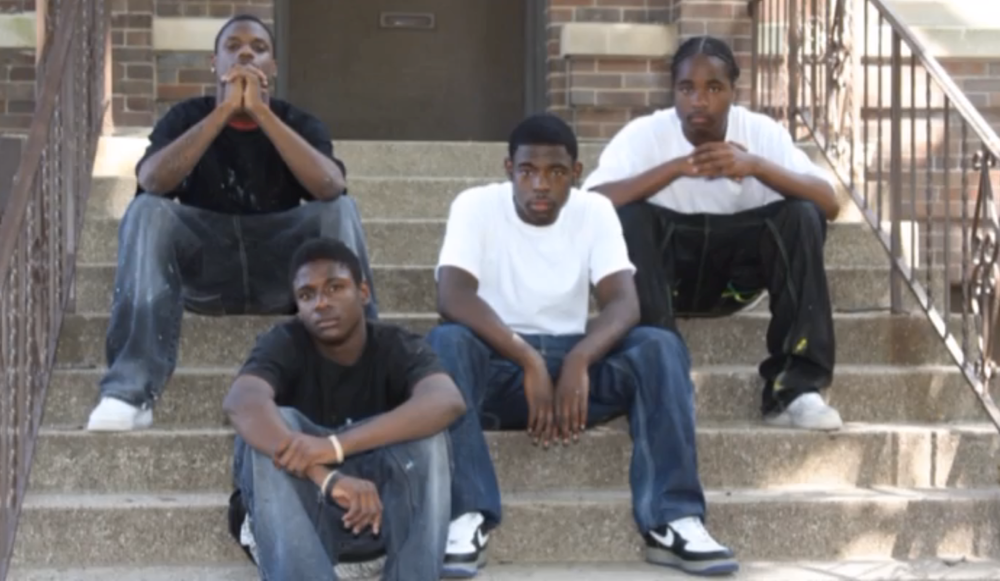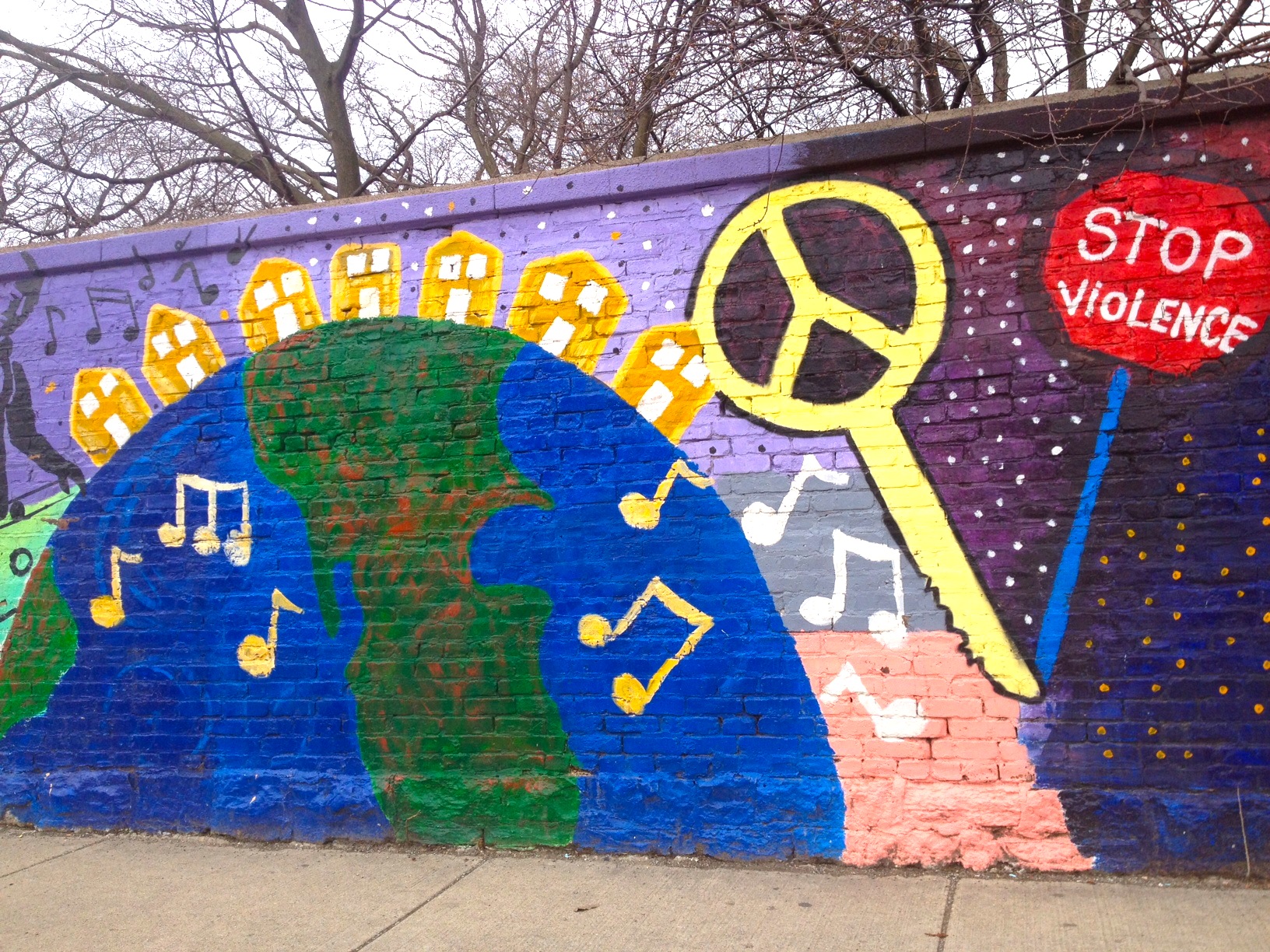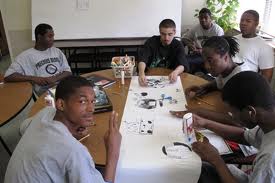“Gun Laws Won’t Impact Us Here” in the Line of Fire, Say Peace Workers: Part 2 of 4
Categorized as: Stories on July 14, 2013.

In Chicago, the U.S. city that suffers the highest rates of gun violence and murder, a small team of unlikely adults employs a surprising technique to try to keep their kids alive. Part 2 in our 4-story series dives into the systemic poverty and violence on the South Side, and the holistic program PBMR built based on feedback from their neighbors here.
Read Part 1 here.
Read Part 3 here.
Read Part 4 here.
The Sharp Edge of Urban Poverty
Chicago, IL: “Poverty just feels different here,” muses PBMR program director Sister Donna Liette, who believes that “3/4 of Chicago residents are wealthy, living in nice houses in the suburbs.” Donna was recruited to join The Center because of her expertise in addiction and incarceration recovery. “You can just tell when you’re driving, say, from downtown to the Back of the Yards. There are more people walking, because they don’t own cars. Their idea of personal care is different. You’ll see more homeless and mentally ill folks sitting on the corner, maybe talking or yelling to themselves . . . more police cars roaming, bars on windows, boarded-up windows. And of course, along with poverty comes crime.”
A tiny white nun with glasses and grey hair, Donna rolls down her window to wave to everyone she passes on the street, from heavily armed police patrols to clusters of men she knows to be gang members. Donna and her roommate and coworker, Sister Carolyn Hoying, cruise around the blocks surrounding The Center.

 Sister Donna Liette counsels youth and their mothers; Diana Rubio teaches art as therapy.
Sister Donna Liette counsels youth and their mothers; Diana Rubio teaches art as therapy.
They want to be fully present where their youth live. Carolyn spent yesterday visiting a boy at his home here. Under a nearby overpass bridge, the nuns pause to view murals depicting prison and death, school and life, hope and pain and peace. Directed by The Center’s resident artist Alberto Alaniz, this series was painted by members of their “Mothers for Peace” activist group for mothers who’ve lost sons to prison and death.



 Murals painted by mothers who’ve lost sons to gun violence. The project was sponsored by the PBMR Center.
Murals painted by mothers who’ve lost sons to gun violence. The project was sponsored by the PBMR Center.
“Youth are in a way confined here, kind of imprisoned from birth into poverty,” Donna sighs as she surveys the boarded-up and broken-down buildings where The Center’s kids live. “One day, I was driving a boy from the inner city and we passed Lake Michigan. He asked me in all honesty, ‘Is that the ocean?’ He’d never seen the lake before.”
“One of the causes of racial and gang violence here,” PBMR founder and director Father Dave Kelly points out, “is that there are no boundaries between people economically, geographically. That means kids can easily come into the ‘wrong’ neighborhood and get jumped.” Lethal or not, adds Cheryl Graves, executive director of the Community Justice for Youth Institute (CGYI), guns have become survival mechanisms here. “If you work at night and you take the bus, and you’re standing there waiting for the bus, you’d better have a gun.”
“Think about it this way,” adds Dave. “With current laws, a wealthy homeowner in the suburbs can protect his property, but a scared teenager can’t carry a gun to protect his life.” Mandatory-minimum laws put teens in prison for three years for gun possession. The peace workers’ strategy?—“We take the kids most likely to kill or be killed and train them as peacemakers,” says Cheryl. “Really.” They went into Harper High School, where 29 students were shot in 2012, and asked 25 students if they’d like to attend peacemaking circle training. They got 20 yeses.
How the Program Works
The PBMR Center serves about 50 current youth members (all but one are male), each of whom has a mentor to check in with them regularly, get to know their families, and take phone calls at all hours. It’s just about being that person the boys can count on. Often, what’s needed is simply a ride across town or even a few blocks away, from The Center to home or school.—If even a short commute involves crossing gang lines, a member’s life can be at risk.
Center staffers work long days, seven days a week, with a surprising demeanor of peace and joy. They are the least stressed nonprofit workers you’ve ever met—and they are quintessential nonprofit: Not one of the seven board members takes a penny as salary.
Youth mentor Mike Donovan does: He came to The Center after he retired from the IRS. He used to manage a team of 4,000 in their Manhattan office; now he works 1:1 with young men trying to stay out of prison, out of gangs, off the streets. Mike works for “a pittance” stipend from the state of Illinois, but he finds himself tucking his pay back into the hands of “his” kids. “Well, they need it,” he shakes his head and laughs ruefully. “They really do—for bus fare, meals, clothes—and I am a man who has a hard time saying no.” Having moved 12 times in his 29.5 years with the IRS, Mike never had the chance to have a family of his own. Now, he profoundly feels that he does.
 Center members creating murals.
Center members creating murals.
The Center offers a safe place to be and plenty of art, music, theatre, and sports to do. They also hold peacemaking circles for youth once a week, and for their mothers on weekends. They place a strong emphasis on artistic expression as a form of healing from the trauma their families have experienced. “We use many forms of art—hip-hop, poetry, painting—to help members with storytelling,” explains Dave. “What they’ve been through, with abandonment and violence, often runs too deep to be expressed with words, so we employ other media to help them get the pain out of their bodies. There’s a connectedness that happens as a result of sharing our stories.”
Art and music tie many of The Center’s staff to one another. “Art is really a form of therapy,” says afterschool program director Diana Rubio. She oversees the ceramics program and sells their products at local fairs; but she will always put down her paintbrush to listen to a Center member or his worried mom. “Everybody deserves a second chance,” suggests 36-year-old Venita, whose 17-year-old son Demetrius currently serves time in the juvenile center for armed robbery. Venita often stops by The Center after work to take refuge in the compassion she finds with staff members. “They are my sisters now,” she smiles.

 PBMR members help unload groceries donated by Trader Joe’s and refurbish furniture for “Project Repay” to make amends for property lost in crimes.
PBMR members help unload groceries donated by Trader Joe’s and refurbish furniture for “Project Repay” to make amends for property lost in crimes.
The Center manages several layers of industry. Project Repay allows offenders to create artistic and improvement projects around the Center—e.g., painting an old donated table—and the hours for their salary go to their victim, to repair damage done or property stolen during the crime. A local Trader Joe’s grocer brings a truckload full of food to The Center on Wednesday mornings, so members help unload and distribute to needy families, many of whom are their own.
Two microbusinesses help support them: a garden project in conjunction with Catholic Campaign for Human Development (and planted with DePaul University interns) that grows fruit and vegetables for members, their families, and the local farmers’ market; and a tee-shirt printing business, with very affordable designs for customers’ businesses or created by Center artists.
It’s young men who fill The Center all week, but often their whole families end up getting involved in the process here. Donna and Carolyn work with mothers who’ve lost sons to homicide and run another activist group, “Mothers for Peace,” and a weekend brunch and peacemaking circle called “Hope and Healing.”
On Saturdays, Denny and Dave load up two vans and take the kids sightseeing to places they’ve never seen in their own city. “They all want to bring their friends and siblings,” Dave grins. “We need more than two vans.” The majority of The Center’s membership is voluntary; sometimes, it’s court-ordered. The Center program stands as a legal alternative to juvenile detention for misdemeanors.
“We try to live out the value of respecting the young person and yet still challenge them at the same time,” Dave says. “It’s not about, ‘When you get better, I’ll love you.’ We accept and love him now and hope he wakes up one day soon and says, ‘You know, selling drugs on the corner just isn’t cutting it for me anymore.’” At 6’4” Dave can command a room.—Yet he doesn’t. “My father was in the Army during WWII and then worked in a factory for 40 years.—He was very strict—so I’m learning all the time about how to relate to the kids in another way,” he says with his face and hands wide open.
However, Center staff won’t do just anything asked. Currently, one member’s mother has been calling Donna at all hours requesting random rides, as though with a free taxi service—and she usually receives a gentle “no.” A teenager named Danny called Denny to transport him safely from his mother’s to his sister’s house . . . But it just so happened that he’d jumped bail and was on the run from the police, so, “Sadly, I had to say no, we don’t harbor fugitives of justice,” Denny shakes his head.
City poverty seems insoluble, but not so to The Center staff. “If you listen to their stories,” Dave says, “you’ll soon understand there is a clear reason why there is so much violence here. There is no singular police, court, or community system that can handle these problems alone.”
The Center does more than most, working in close conjunction with the local court and juvenile detention center. The Cook County Detention Center’s board president, Toni Preckwinkle, sees The Center’s work as invaluable to Chicago’s youth. “Unfortunately, many of the young people who get involved in our juvenile justice system do so because they are disconnected from their families, schools, and neighborhoods,” she says. “What I appreciate about Father Dave Kelly and the work of Precious Blood Reconciliation Ministry is that they utilize restorative justice practices to listen to our youth, address issues of accountability, and support them as they seek to reconnect to their communities.”
Employing the Unemployable
Members train in job skills and consult with Mike to find entry-level jobs—often, with a resume bearing a felony charge and no permanent address or telephone number, work experience or high-school diploma. Mike accompanies ex-convicts when they re-enroll in high school, helps navigate registration for college, and drives boys to job interviews. He teaches them to drive, helps acquire ID cards, formats their resumes, and spruces them up for interviews. An avid football fan, Mike takes lucky Center members to share a hot dog at Northwestern University Wildcats’ games, for which he holds season tickets.
 Mike Donovan (L) teaches PBMR youth to drive, helps them craft resumes, and spruces them up for job interviews.
Mike Donovan (L) teaches PBMR youth to drive, helps them craft resumes, and spruces them up for job interviews.
“The jobs program is frustrating for so many reasons,” Mike says. “You’ve got to remember, there’s no adult in their life who ever has had a job. They have no example of someone getting up and going to work. There are no fathers here—they’re dead, imprisoned, or long gone. Mothers are on drugs or have six younger children to care for; and by the time a male child turns 13, he’s on his own.”
While their mothers—many of whom didn’t complete high school or receive skills training of any kind—scrape by in public housing, on food stamps and earned-income credit, their sons “are the first ones to be thrown out. Many of our boys are essentially homeless, flopping from house to house.”
Mike speaks vehemently to the need for education as the boys’ “only ticket out” of poverty, yet completely lacking in quality in Back of the Yards. “A high school diploma here is meaningless,” he says, refusing to mince words. “If you show up to class, you get a C. If you cause problems, you get a D. If you don’t come to school at all, you get an F.” Mike recently attended the high school’s parent night on behalf of two Center members and came away furious that for 500 students, only nine other parents showed up.
He’s witnessed some successes, helping 9/50 current members land fast-food and retail jobs. A few kids work for The Center doing maintenance and gardening, just to get some experience to list on their resumes. 22-year-old Grant, out on parole after a long prison term, saw himself as completely unemployable, until he and Mike spotted an opening on Craig’s List with Jimmy John’s sandwich shop. Grant applied online, got an in-person interview, and got hired on the spot; they never asked about his criminal record. Six months later, he’s the assistant manager and attending community college across the street from his shop.
The Precious Blood Center hosts a peacemaking circle every Wednesday. Anyone from the neighborhood can come to resolve conflicts with others, receive counseling or simply talk about their lives.
Photographs courtesy of the PBMR Center and Suzanne Skees.
LEARN more about The PBMR Center’s holistic care of at-risk and incarcerated youth here.
SHARE this story with your networks; see menus at top of page and below this list.
DONATE directly to provide more youth and families with a safe space to heal, here.
SUBSCRIBE! Like what you see? Click here to subscribe to Seeds of Hope!

